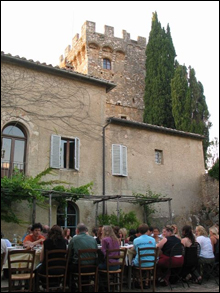
Tuscany. |
Last winter the Maine Legislature formally conferred authority to grant the Ph.D. degree upon George Smith’s nascent Institute for Doctoral Studies in the Visual Arts, based here in Portland. IDSVA thus became the first Ph.D. program in the visual arts in the country, and hit the ground running. The school selected its first class of students, made arrangements for its summer session in Italy, and embarked on what promises to be one of the great experiments in contemporary art education.
As Smith said in a conversation with the Portland Phoenix last fall (see “Critical Intervention,” by Chris Thompson, November 29, 2006): “Teaching theory to MFA students convinced me that artists are incredibly smart. They love theory and philosophy because they love resolving abstract problems, which is the basic process of a studio practice. And yet there has been no Ph.D. designed especially for the artist who wants to pose philosophical questions at the highest level of academic scholarship.”
We tracked Smith down to find out how the first summer unfolded.
When we spoke last fall, ISDVA was nearly up and running and awaiting approval from teh Maine legislature to grant the PH.D. degree. Now you're back from your first summer with your first class of students, and gearing up for an autumn of work together. Tell us about the summer — where you were based, what you read and what the lectures covered, something about the nature of the conversations, the encoungers, the food . . .
We admitted twelve students into our first class — the perfect size for a graduate seminar. We all met in person for the first time on May 15, which commenced our month-long residency at Spannocchia, an unbelievably gorgeous 14th-century castle in Tuscany, just outside of Siena. In the first week Lynette Hunter came to work with us on key terms. Lynette is director of graduate studies in performance at UC Davis, so there was a lot of talk about theory, mind and body. In the following week James Elkins arrived. Jim may be one of America’s preeminent art historians, but his deeper interest lies in the how and why of art making. So while he gave several terrific lectures on theoretical topics ranging from primitive aesthetics to hermeneutics, he also spent a lot of time with students one on one, to see where the connection was between their studio practice and the philosophical aspects of their process. After Jim left we settled down to two seminar sessions a day — lectures in the morning and seminar presentations in the afternoon, focusing on the critical anthology Art in Theory from 1900 to 2000. Conversation buzzed around the clock — everything from Buddha to dada to Heidegger and Marilyn Monroe.
Spannocchia is an 1100-acre organic farm and produces everything from prosciutto to honey and wine, plus they have a fabulous kitchen staff, so you can imagine the meals. And the pastries! On weekends we ventured into Siena and Florence for special assignments. Then in early June we took the express train up to Venice, for a week of critical intervention at the Biennale. Highlights were a full day spent with the artists and curator of the New Zealand collateral exhibition — an amazing mixed-media installation in a cavernous 15th-century salt warehouse on the Grand Canal. We again were hosted on the Grand Canal at the Peggy Guggenheim Museum. Guggenheim director Philip Rylands and freelance curator Sharon Hecker gave us a talk on Jenny Holzer’s 1990 Biennale exhibition at the American Pavilion, which they had installed.